A detailed guide for how to smoke a fresh ham at home including seasonings, flavor injections, glaze preparation, wood choices, smoker settings, cooking times, and target internal temperatures.
Whether you've got a gas grill, a Traeger or Pit Boss pellet grill, or even a Masterbuilt electric smoker, we've got you covered!
Let's get started!
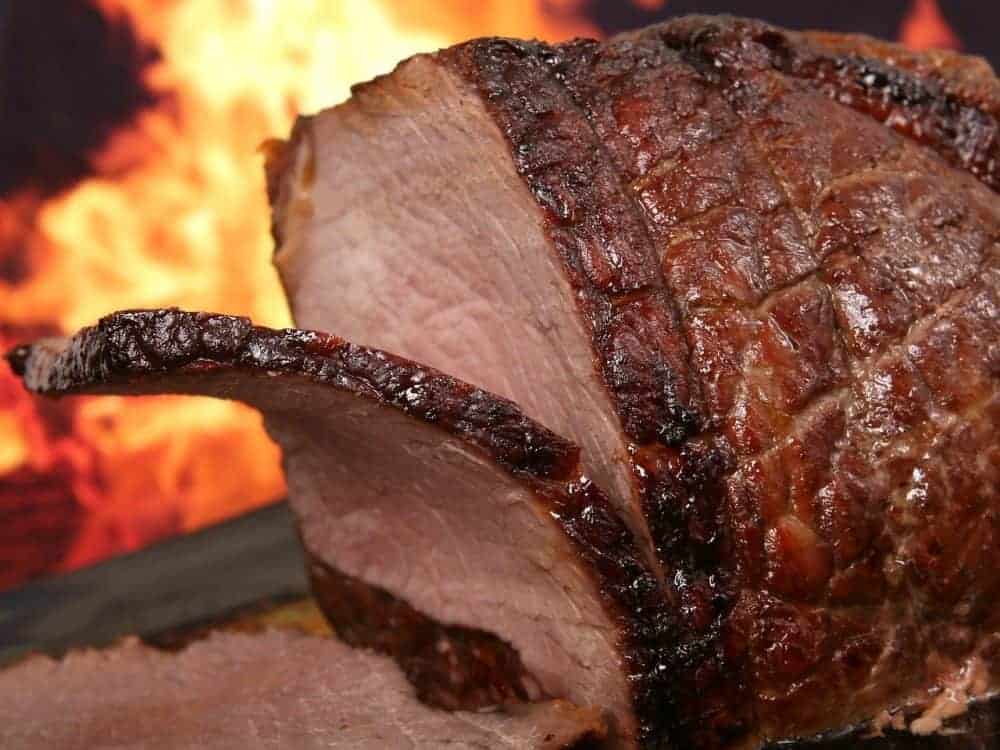
As you probably know by now, we love smoking meat around here. The fire, the wood, the aroma, the perfect excuse to be outside all day enjoying your patio and a couple of drinks with some close friends.
Smoking, and using a smoker, is a great technique to learn if you’re passionate about food and like to try out new things.
Of course everyone talks about the classic meats to smoke like chicken, pork shoulder, ribs, and even steaks. But why not mix it up a little and give that holiday ham a go on the smoker this year?
Did you know most ham purchased in the US is already cooked and is merely reheated in our oven? So it is very likely you have never even tasted a freshly cooked, much less smoked, a FRESH ham in your life.
Most pre-cooked hams are all made using the same basic brine and curing process that turns the meat it's signature pink color, but also leaves the ham flavor a little unimaginative and straightforward.
With an uncured fresh ham, you have a blank canvas to work with and can add your own signature flavors through your choice of seasonings, injections, brines, and wood smoke flavors.
What better way to enjoy this delicious part of the pig than to flavor and season it, make it your own, and cook it on that beautiful smoker out back?
Today we are going to go over everything you need to know to learn how to smoke a fresh ham.
Choosing a Fresh Ham to Smoke
First thing’s first, we need a fresh, quality ham. And you need to make sure it is a RAW, FRESH, ham.
Not Pre-cooked, Not Cured, Not Country Ham.
These all essentially mean the ham has already been brined and smoked before we even get to it.
Finding a raw ham may be more difficult than you would assume as we mentioned before most hams sold in the US are pre-seasoned and pre-cooked.
You'll likely have better luck going to a local butcher shop than a chain grocery store in order to find this. Make sure to call and ask first what they have available.
Once you've found a selection of raw hams, here are a few things to help you decide on which one to choose:
Seasoning
Check to make sure the raw ham is not already pre-seasoned or brined.
We are looking to make our own flavorings and injection for this ham so we want a blank canvas to start with.
Weight
You’ll need to think about servings, timing, and how much you want leftover when it comes to the size and weight of your ham.
You'll also need to decide if you want to smoke a half ham (usually the shank cut) or a whole ham.
Anticipate losing about 20% of the hams weight during smoking, so if you start with a 16 lb ham, it will weigh roughly 13 lbs when it's done cooking.
According to Marthastewart.com, you should estimate about ¾ lb of cooked ham per person for bone-in ham, and ½ lb per person for a boneless ham.
Keep in mind that it will also take between 25 to 35 minutes per pound to smoke your ham (the lower end if boneless, the higher end if bone-in).
So if you’ve settled on a monster whole bone-in 16 pounder for an epic party, you could be looking at a full 8-hour smoking session or even longer.
Cut
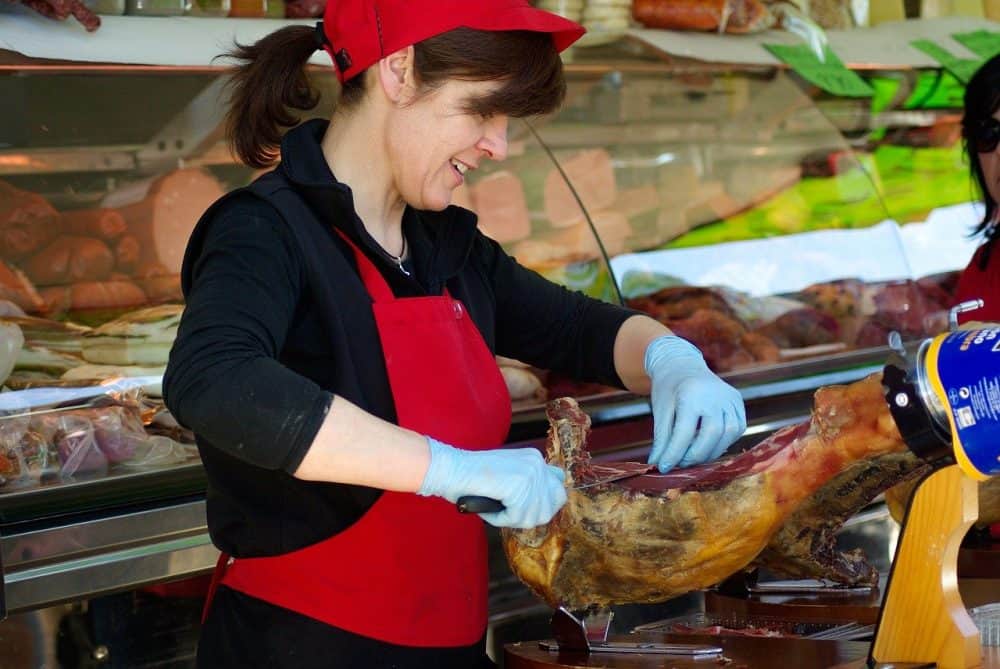
If you want to understand the terms the butcher will likely use when you are ordering your ham, you need to understand some basic anatomy of where the ham comes from on the pig.
If you’re going for the richest flavors, the longest cook time, and want to feed an army, ask for a WHOLE fresh ham, which will include both the shank and butt cuts of the meat.
If you have that traditional half ham roast centerpiece in mind, you’re likely thinking of a shank-cut (pictured above). The shank is basically the lower half of a whole ham, located further down the leg and is a leaner part of the ham.
Meanwhile, a whole ham also includes the butt-cut which is richer and fattier. So keep this in mind when slicing your whole ham later on depending on each guest's preference.
A final note: Ask your butchers to french the ham bone out if they haven't already done it already. This will create a more classic presentation, and make the ham so much easier to slice once its done.
Choosing a Smoker for your Fresh Ham

If you’ve had experience smoking other large cuts of meat such as brisket and pork shoulder, then setting up the smoker for this cook will be nothing new to you.
A fresh raw ham can be smoked in almost any style of smoker big enough to accommodate its size, whether it is a charcoal or vertical smoker, pellet smoker, even propane or electric.
You can technically even smoke your ham right on a gas grill using a smoker box or a pellet tube smoker.
What's important is that you can reach and maintain the desired temperature, add the amount of smoke flavor you wish, and that your smoker has enough space to accommodate the size ham you are planning to smoke.
For the novice bbq enthusiast, we are big fans of the Zgrills line of pellet smokers. These affordable entry-level smokers offer "set it and forget it" temperature control and amazing smokey flavor as they use wood pellets not only for smoke, but as their heat source.
You truly get a wood fire smoked piece of meat on a pellet grill with no other fuel sources.
Preparing your Fresh Ham for Smoking
You'll notice if you watched the video above that the cook chose to wet brine his ham for a day before cooking.
There is nothing wrong with doing this, however, you can achieve similar results, without the mess and the giant brining bucket, with a combination of a marinade injection and a good dry brine rub.
Ideally you will inject and season your ham the day before you plan to smoke it.
Fresh Ham Marinade Injection
Traditional cured hams are soaked in a salt solution that brines and cures the meat all the way to the center, resulting in the salty seasoning, rubbery texture, and pink hue you've become accustomed to.
Our fresh ham will end up with more the texture of a sliced pork shoulder, which is delicious, but unlike a pulled pork shoulder we can't cheat and add salt to it later like we would to a big tray of pulled pork.
We will be slicing the ham which means we need to get that salt and seasoning deep into the meat BEFORE we cook so that each slice doesn't end up with seasoned edges and a bland interior.
For this injection you will want a good quality meat injector, like our favorite affordable option from from Ofargo that you check out here. and we are going to use a combination of sweet and salty ingredients.
- ✅【Leak & Heavy Duty for Years】culinary stainless steel/zinc alloy metallic material (a little heavy injector syringe); sturdy turkey injector needles, easily to pierce the toughest cuts of meats or poultry; silicone basting pastry brush working well in high cooking/grilling temperature range
- ✅【Easy to Use & Dishwasher Safe】Ergonomic threaded design, easy to assemble or dismantle. 2-oz large capacity injection barrel minimizes refills; 3-Ring handle offers a comfortable grip and friendly pressure control; 3 interchangeable turkey needles w/ multi-holes for deep penetration and perfect sauce distribution, like chunky marinades or liquid brine.
You can also cut down on the sweet ingredients depending on your diet and your preference.
Injection:
- ⅓ cup of dark brown sugar
- 3 tablespoons butter
- ½ cup of apple juice
- ¼ cup of pineapple juice
- 1 and ½ tablespoons of Worcestershire sauce
- ¼ cup of salt
- 1 cup of water
Add all the ingredients to a saucepan and bring just to a simmer and mix until dissolved. Let it cool to room temperature (you can add a couple ice cubes if you need to speed this up) and then inject the cooled mixture throughout your ham.
Keep your ham in the netting it came in and in an aluminum roasting pan while you do this to minimize the mess.
The Best Rubs and Seasonings for a Smoked Fresh Ham
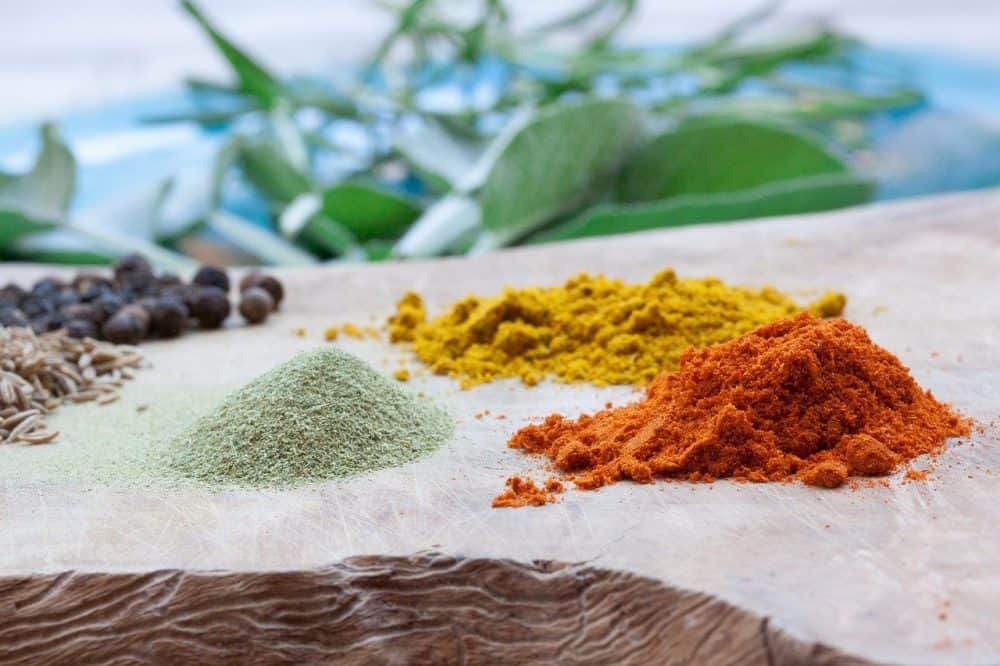
Now for the exterior.
Your ham may have come in a netting to help it hold its shape. Leave it in the netting for now and apply your rub right over the netting. After it has cooked most of the way we will remove the netting before applying the glaze and you will see the bark from the rub will mostly remain intact.
If your ham does NOT have a netting, we recommend scoring some diamonds into the exterior fat as shown in the video below.
This will allow the rub the better permeate through the fat layer and into the meat and also create a more elegant presentation.
If you’ve got a tried and tested savory bbq dry rub that you swear by, fantastic! Use that.
However, because we are going to be adding a sugary glaze later in the cook, and we just injected all those sugary juices into the interior, we recommend going easy on the sugar based rubs for now and choose something more savory.
This is the point in which you want to add those savory umami flavors to your ham that will hold up to the fatty meat and sugary glaze later on.
If you’re unsure about what to use, our favorite sugarless bbq rub is Bad Byron's Butt Rub.
You can use it on anything from pork to chicken to steak. It's delicious, and contains no sugar or sweeteners, only salt and savory spices.
- Used by championship barbequers, professional chefs, and backyard cooks everywhere
- Balanced blend of onion, garlic, salt, pepper, paprika and chipotle (smoked jalapeno)
- Outdoor flavor at its finest
- A great all-purpose seasoning
If you have some spices on hand and want to take a go at preparing your own rub, we’ve got you covered with this quick and easy recipe.
- Black pepper
- Salt (Kosher or sea)
- Dried thyme
- Yellow mustard powder
- Garlic powder
- Onion powder
- Smoked Paprika
Don't go too crazy with the mustard, garlic, and onion powders, a little goes a long way. What you want is a rub that is mostly salt based, with enough to cover the entire outside of the ham, and the other seasonings there to add some complexity of flavor.
Play with the ingredients and the colors of your rub and don't get too hung up on it being perfect. BBQ is about experimentation and finding your unique style.
Coat the outside of your ham with a thin layer of vegetable oil or even better, yellow mustard (yes it's fine, you won't taste all that mustard later but it's a great binding agent for most rubs.) and then apply the rub all over the ham generously.
Place it on a cooling rack set on top of a baking sheet in the refrigerator, uncovered, for at least 2 hours, 4-6 is better, overnight is ideal.
- The baking sheet with wire rack every kitchen needs; Ultra Cuisine’s baking sheets for oven use and cooling racks for baking, roasting, broiling, air frying, cooking; use separately or together; your culinary possibilities are endless
Dry Brining Overnight
If you remember anything about osmosis from high school science class, you'll remember salt and water like to balance out, so the salt is going to travel via the water in the ham to places where there is less salt.
You are using this time to let the salt permeate the exterior of the ham from the rub, as well as the interior from the injection, and create a more evenly seasoned flavor throughout the ham.
Another benefit of osmosis is that the salt helps retains moisture in the ham during the long smoking process.
Salt and water are buddies and once they find each other, they don't like to separate.
So brining, whether dry or wet, not only gives you the benefit of the seasoning, but also a more moist ham after a long smoke.
If only they had assigned us to make a deliciously barbecued ham back in high school science lab!

Fresh Smoked Ham Glaze
The glaze will be the final touch on the ham and get applied late in the cook in the last hour or so.
However, you can prepare it ahead of time if you wish.
DO NOT apply the glaze to the raw ham before you start smoking it.
Your glaze will burn before the ham is finished cooking. It goes on at the end.
Again, there are many styles of ham glaze on the market if you want to save time and purchase a pre-made batch.
We are fans of Braswell's Montmorency Cherry Ham Glaze in particular. Make sure to warm it up a bit before you apply it later on.
- Brush Generously Over Hame during Final 15 Minutes of Baking
- Under 40 calories per serv
Prices pulled from the Amazon Product Advertising API on:
Product prices and availability are accurate as of the date/time indicated and are subject to change. Any price and availability information displayed on [relevant Amazon Site(s), as applicable] at the time of purchase will apply to the purchase of this product.
If you want to make your own glaze, you can follow the guidance in the video above, or try this recipe below. Adjust the measurements according to the size of your ham. Here’s what you’ll need:
Glaze:
- ¼ cup of dark rum (optional)
- ½ cup of honey (or syrup if need be)
- ¼ cup of yellow, or preferably, wholegrain mustard
- ¼ cup of pineapple juice
- ¼ cup of butter
- ¼ cup of dark brown sugar.
An example of scoring the meat before applying the rub on a smaller non-netted ham:
How to Make a Smoked Fresh Ham
Start up your Grill or Smoker
You will want to bring your smoker up to about 225-250 deg F. If your smoker comes with a water pan, like the Weber Smokey Mountain, fill the water pan as well to help stabilize the temperature and add moisture to the cooking chamber.
If you do not own a smoker, you can achieve similar results using a smoker box on a gas grill as we detailed in this article. However, it will require some closer attention throughout the day.
The Best Wood Choices for a Smoked Fresh Ham

Unless you are using a pellet smoker, you will also need to choose your preferred wood chunks or chips.
For a fresh ham, especially if you want to infuse some holiday flavor, our favorite choices are cherry and pecan, or a combination of both.
Once the smoker is up to temperature, chunks can be placed directly onto hot charcoals while chips must be placed in aluminum foil, a smoker box, or the smoker box chamber of your electric smoker to restrict their oxygen exposure and keep them from igniting.
Put the Fresh Ham on the Smoker
Remove your ham from the refrigerator where it has been dry brining, preferably overnight, and you can let it sit on the counter for up to 30-45 minutes while your smoker comes up to temperature.
The best smoke flavor is absorbed when meat is COLD, so there is no need to let it come up to room temperature before putting it on the smoker.
If your butcher frenched the bone out of the ham, which we highly recommend asking for, you will want to wrap the bone in aluminum foil to keep it from turning an ugly charred black.
When the smoker is up to 225 deg F and you have smoke going, put the ham in and close the lid.
Make sure to use both a temperature probe for the cooking chamber as well as for the meat itself.
We have been liking this wireless dual meat and cooking chamber probe set from ThermoPro because it is an easy to use and affordable workhorse around the smoker.
- Hands free monitor: Wireless digital meat thermometer with dual probe monitors food or oven/grill/smoker temperature up to 300 feet away, enabling you to enjoy your company without continuously excusing yourself
- Hassle-free setup: No synchronization required, say goodbye to the tedious setup steps; Large LCD displays both food and oven temps; Back-lit for use in low light condition
While we have used and recommended ThermoPro for years, lately we have also become big fans of the MEATER leave in thermometer.
It is extremely accurate and has an incredible 165 foot bluetooth range and works right with your smartphone so you don't need to carry a separate controller around with you like many other remote thermometers require.
It's got a great free app that is constantly being updated and even has an algorithm to predict how much longer your type of meat will take to cook based on cooking temperature, target temperature, and current internal temperature.
It's like a GPS for your meat!
- ► 2 Sensors, 1 Probe: Dual temperature sensors can monitor internal meat temperature up to 212°F and ambient / external temperature up to 527°F simultaneously. Dishwasher safe.
- ► Advanced Estimator Algorithm: Can estimate how long to cook and rest your food to help plan your meal and manage your time.
- ► Connectivity Suite: Monitor your cook from a phone or tablet over Bluetooth. Extend your range Using MEATER Link WiFi and MEATER Cloud to use Alexa and monitor your cook from a computer.
Anyways, back to our smoked fresh ham...
Insert the meat probe into the center of the ham making sure not to touch the bone if it was not frenched out of the ham by the butcher. This will give you a skewed reading.
The Best Cooking Temperature for Smoking a Fresh Ham
Try to maintain a temperature of 225-250 deg F, and no higher than 275 deg F throughout the cook.
As stated previously, the ham will take anywhere from 25-35 min per pound to smoke at this temperature.
Keep in mind, this is not an exact science!
Other factors like the cut and fattiness of the ham, whether it is bone-in or boneless, how much injection you added, how constant you keep the temperature of your smoker and how accurate your cooking temperature reading is will all affect how long it takes to smoke your ham.
So...
Give yourself plenty of time to cook before your guests arrive.
Even if the ham is done 2 hours before you slice and serve it, you can hold it in a 170 deg warm oven and it will still be delicious. More on that later.
Better to be finished early than to have 10 hungry guests staring over your shoulder at a stubborn piece of meat that will not come up to temperature.
Anyone who's barbecued for any length of time has probably been there before 🙂
Target Internal Temperature for a Smoked Fresh Ham
If you are familiar with making pulled pork, you know the internal temperature target is usually around 195-205 deg F. That's the beautiful, magic range where pork just falls apart.
However, we are cooking a ham, not pulled pork.
We don't want to go quite that high because we want the meat to stay intact enough to be sliced, not pulled.
So our target internal temperature for the ham is going to be 175 deg F.
But before we get to that temperature, we will want to prepare and apply the glaze.
Applying the Glaze
Bring the ingredients listed above in the glaze section just up to simmer to dissolve the sugars in a small saucepan and then take the pan off the heat and let it cool slightly.
If you are using a store bought ham glaze, just warm it up a bit in the saucepan to thin it out and make it easier to apply.
When your ham has risen to an internal temperature of about 160 deg F, it is time to apply the glaze.
If you ham has been in a netting this whole time you can now carefully remove the netting with some kitchen shears, and then apply the glaze generously all over the ham with a basting brush.
Prices pulled from the Amazon Product Advertising API on:
Product prices and availability are accurate as of the date/time indicated and are subject to change. Any price and availability information displayed on [relevant Amazon Site(s), as applicable] at the time of purchase will apply to the purchase of this product.
You can do this right on the smoker as he does in the video above.
Close the lid and let the glaze caramelize and take hold while the ham comes the rest of the way up to our target 175 deg F temperature.
Resting and Serving the Ham
Once the ham is finished, remove it from the smoker, and let it rest in another large aluminum foil baking pan for at least 30 minutes before slicing it.
Once you begin slicing, serve immediately.
If your ham finishes more than an hour before you plan to serve it, no worries. We recommend simply placing it in a warm 170 deg oven.
This temperature will hold the meat at a food safe temperature without overcooking it or burning your glaze. You can relax and greet your guests, taking the ham out to carve once everyone is actually ready to eat.
Digging In
So there it is. Your fresh raw ham is smoked, your table’s set, and your guests are drooling. This will truly be a ham unlike most of them have ever tasted before.
Have fun with choosing the cut and size of your hams, as well as playing with the rub, injection, and glaze.
Over time, make the recipe your own unique creation.
That's what BBQ is all about!
Other Smoker Recipes
Looking for some inspiration?
Check out some of our favorite recipes below that can easily be done on a pellet grill, gas grill with a smoker box or pellet tube, offset barrel smoker, or a vertical electric or propane smoker.
- Smoked Leg of Lamb with Guinness Marinade
- Smoked Lamb Chops with a Balsamic Butter Sauce
- Smoked Rack of Lamb with Garlic and Rosemary or Smoker
- Smoked and Pulled Lamb Shoulder with a Turkish Spice Rub
- Smoked Oysters in a Garlic White Wine Sauce
- Smoked Bratwurst with Beer Braised Onions
- Grilled Bratwurst
- Smoked Gouda Cheese
- Perfect Grilled Hamburgers
- Pellet Grilled Steak
- Pellet Grill Turkey
- Trash Can Turkey - OK, technically not made on a grill but one of the most fun ways there is to cook a Turkey...at over 700 degrees in only 2 hours! You've got to check it out!
📖 Recipe
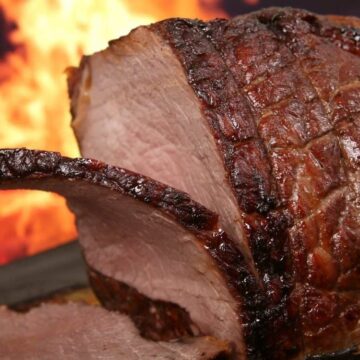
Smoked Fresh Ham with Dark Rum Citrus Glaze
Equipment
- Smoker
- Marinade Injector
- Several Large Aluminum Foil Trays
- Baking Rack
- Charcoal (if needed)
- Wood Chips or Chunks for Smoking
Ingredients
- 1 Fresh Ham (Whole or Half) Preferably with Bone Frenched
- Wood Chips or Chunks for Smoking
- Olive Oil or Yellow Mustard to Coat Ham for Dry Rub
Marinade Injection
- ⅓ Cup Dark Brown Sugar
- 3 tablespoon Butter
- ½ Cup Apple Juice
- ¼ Cup Pineapple Juice
- 1 and ½ tablespoon Worcestershire Sauce
- ¼ Cup Kosher Salt (Adjust for preference)
- 1 Cub Water
Dry Brine Rub
- Black Pepper
- Kosher Salt
- Dried Thyme
- Yellow Mustard Powder
- Garlic Powder
- Onion Powder
- Smoked Paprika
Dark Rum Citrus Ham Glaze
- ¼ Cup Dark Rum (Optional)
- ½ Cup Honey
- ¼ Cup Yellow or Wholegrain Mustard
- ¼ Cup Pineapple Juice
- ¼ Cup Butter
- ¼ Cup Dark Brown Sugar
Instructions
- Remove Ham from packaging but leave netting on ham if present.
Marinade Injection
- Add all the marinade injection ingredients to a saucepan and simmer until combined and dissolved. Remove from Heat and add 2 ice cubes and let marinade come to room temperature
- Place the ham on a baking rack in a large disposable aluminum foil pan or roasting pan. Inject the marinade into the ham in multiple areas with a meat injector.
Dry Brine Rub
- Combine the dry rub ingredients in a medium bowl. Amounts are left out purposefully so that you can experiment with or omit various flavors.
- Cover the ham in olive oil or mustard and then apply the rub generously all over the outside of the ham without removing the netting.
- Place the entire roasting pan in a refrigerator uncovered and let sit at least 4 hours, preferably overnight.
Prepare Smoker
- Light your smoker or grill setup for indirect heat and preheat to between 225 and 250 deg F.
- Add your wood chips in a smoker box placed over a burner or wood chunks to the charcoal to create your initial smoke.
- Place the Ham on the Smoker with an internal probe thermometer in place and close lid, maintaining a temperature of 225-250 deg F.
Dark Rum Citrus Glaze
- Once the ham is on the smoker, assemble your glaze ingredients and combine them all in a medium saucepan.
- Bring the ingredients to simmer for 2-3 minutes and allow all the sugars to dissolve. Remove from heat to let cool and thicken.
Apply Glaze
- Check the internal temperature of the ham. Once it has reached 160 deg it is time to apply the glaze.
- Leave the ham on the smoker. If there was a netting in place on your ham, use kitchen shears to remove the netting now.
- Apply the glaze liberally right on the smoker to all sides of the ham with a silicone grill brush and reclose the lid.
Finish Cooking Ham
- Leave the ham on the grill until it has reached 175 deg F with an internal probe thermometer.
Remove, Rest, and Slice
- Carefully remove the ham from the smoker and place in a large roasting pan
- Let the ham rest for 20-30 minutes before slicing. If your guests are not ready you can HOLD the ham in a warm 175 deg oven until time to slice and serve.
- Slice the ham carefully in ¼ inch thick slices and serve immediately.
Video
Nutrition

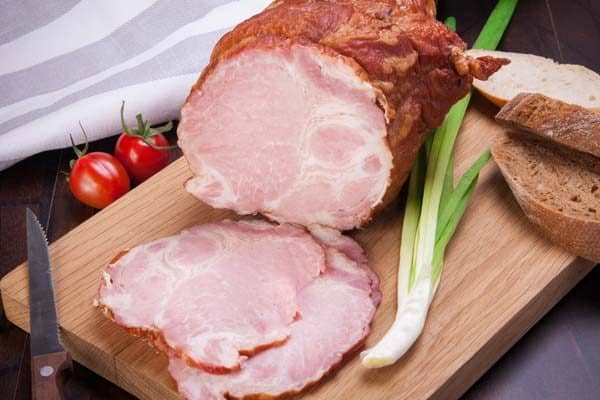

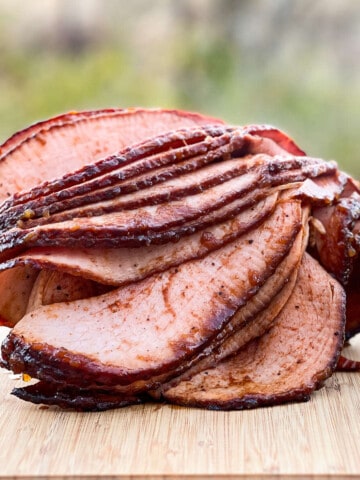
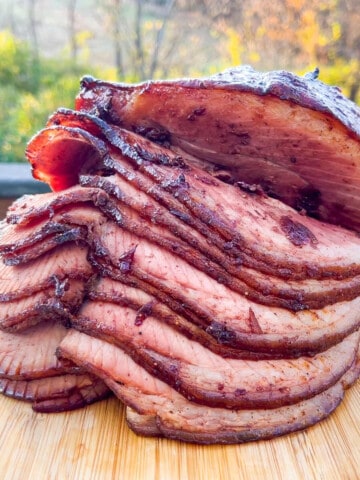
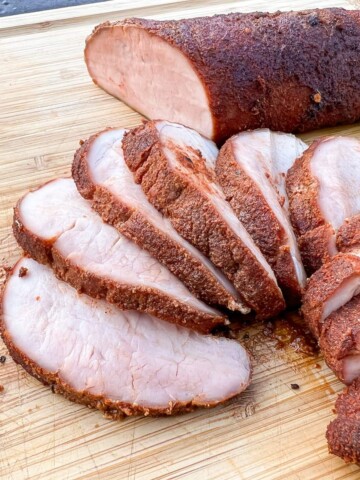
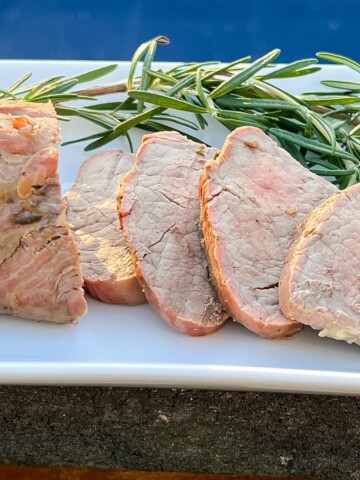
Tom says
Delicious!
Ben says
Made this for Thanksgiving instead of Turkey. Used a hard cider instead of apple juice for the injection and came out nice. Will defiantly be switch to raw hams from now on!!
B.K. says
Smoked one along with the turkey this year, everybody kept going back for ham!